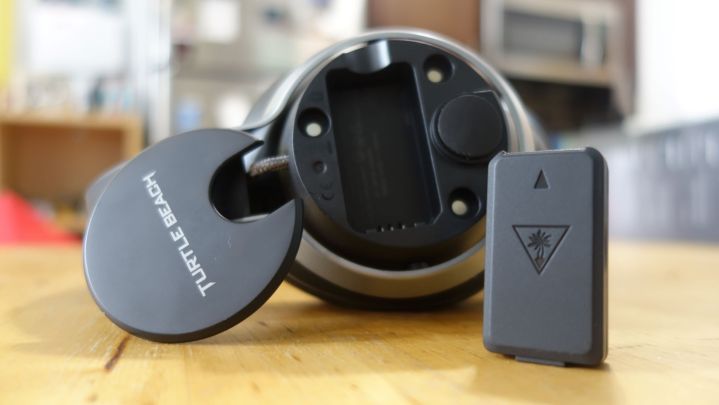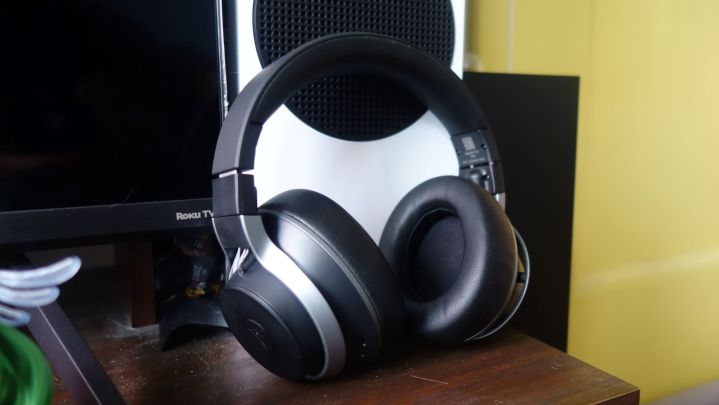“Turtle Beach's Stealth Pro gaming headset is packed with useful features that justify a high price tag.”
- Discrete design
- Comfortable fit
- Great audio quality
- Innovative battery solution
- Loaded with features
- Pricey
- Mic quality is so-so
- Some complicated features
The more “Pro” a headset becomes, the more hurdles its manufacturer must clear. Every added feature is going to need some extra ingenuity to avoid a headset that’s covered in buttons. Each new tweak is sure to drive up the price a little more each time too. There’s a tricky balance to land between ease of use, affordability, quality, and features. You can see those tensions play out in Turtle Beach’s excellent, but somewhat complicated Stealth Pro headset.
There’s so much going on in the Stealth Pro that it’s hard to run through it all in a concise manner. For a hefty $330, you’re getting great sound quality via its 50mm drivers, powerful active noise cancellation (ANC), two microphone options, a swappable battery, a wireless transmitter that charges an included second battery while you use the other one, compatibility with just about every gaming device, and a sizable customization suite via Turtle Beach’s app. While there’s not so much a catch to all of that, there are some design quirks that allow Turtle Beach to pack it all in.
If you can adapt to some complicated features and have over $300 to spend, the Turtle Beach Stealth Pro is a top-tier gaming headset worth investing in. It’s quickly becoming my go-to audio device thanks to its comfortable design and innovative battery solution that solves one of my biggest gripes with wireless headsets. I just need to teach myself to stop fiddling with it in public.
Design and comfort
The biggest compliment that I can give the Stealth Pro is that it doesn’t look like a gaming headset. There’s a trend happening in the space right now where manufacturers are ditching loud, colorful designs for discrete ones that make them more viable as cans you can use in public. Turtle Beach follows that trend here with a simple black and silver design with only a few unobtrusive logos and no RGB accents.

It’s quite the sturdy headset too, with a metal-reinforced headband that feels like it’ll hold up well in the long run. That can make it feel a little stiff, as there’s a fair amount of resistance when trying to adjust it, but it’s a big upgrade over the overly plastic feel of the base Stealth models. I usually feel a bit self-conscious when testing a gaming headset out on a NYC train ride, but the premium look and feel here put that worry to rest.
I’m especially happy with the comfort factor so far. At first, it felt a little tight and I figured it’d squeeze my head a bit too much. That discomfort never came during my testing thanks to its incredibly soft memory foam ear cushions and headband. I was keeping it on for hours at a time without thinking about it. I’m not entirely sure how it’ll fit bigger heads, but it seems flexible enough that it should adapt easily while retaining a snug fit.
Audio quality
It doesn’t come as much of a surprise that the Stealth Pro wins in audio quality. Turtle Beach knows how to make a headset that’s correctly balanced for gaming at this point in its storied career. The 50mm Nanoclear drivers here produce incredibly clear sound where no frequency range feels lost. Bass, mid, and high tones all come through pretty much where I expect them to and Turtle Beach offers a fair amount of customization to tweak the mix to my liking. Naturally, there’s the company’s signature Superhuman Hearing feature, which helps boost sounds like footsteps. Then there’s the audio hub app that lets me easily tweak my EQ presets on the fly too.
I’m especially impressed by the noise cancellation here, which cuts out a ton of sound. Room tone is virtually removed when I’m a game, letting me fully focus my attention on something like Octopath Traveler 2’s excellent score. There’s a mic monitor available if you want to bring in some outside noise, but I’d suggest fiddling with it through the audio hub app first. At its default, the monitor is incredibly noisy. When using it on a train, I was left with an earful of harsh, peaking audio.
The Stealth Pro is a fantastic gaming headset overall that solves several issues I have with devices like this.
Microphone quality isn’t too bad either, though I find that I’m rarely entirely satisfied with that aspect of gaming headsets — and at $330, this isn’t raising the bar as much as I’d expect. What I do appreciate, though, is that the Stealth Pro includes both an in-line microphone and a detachable boom. The former isn’t preferable, with a hollow, echo-filled tone that picks up a lot of room tone, but it’s nice to have a built-in mic I can use in a pinch if I don’t feel like breaking out the attachment.
The boom produces a much clearer sound that I’d feel a lot more comfortable subjecting my teammates to. It’s a touch tinny, but my voice comes through clearly, with a comparatively light layer of room tone getting through. It can be muted by flipping the microphone up, which can create a slightly annoying microphone handling sound. I also have run into situations where the microphone randomly mutes for a few seconds without me touching it. Despite that, the feature works well considering I can flip it all the way out of my face with ease and get an audio cue confirming it’s off.

The microphone situation is where I start to run into some of the headset’s “premium” quirks. In what seems to be an effort to keep the design as quiet as possible, the microphone jack is covered up by a small plastic cap on the left earcup. Anytime I want to use the mic, I’m left praying that the tiny cover doesn’t get lost, leaving an unsightly hole right on the side. It’s one area where the Stealth Pro feels a bit overdesigned, as an uncovered port off to the edge seems unobtrusive enough. It’s just one of a handful of odd choices you’ll need to live with to get that Pro feeling.
Battery
That comes up again with its innovative approach to battery. Turtle Beach says the headset lasts about 12 hours on a charge, which roughly seems accurate (though 10 might be a closer estimate). It’s a little low considering the price tag, but what’s neat is that the battery can be easily removed and replaced with a second one that comes bundled with the headset. Replacing it is as simple as popping off the plastic cover on the left earcup, slotting the new one in, and putting the cap back in place.

OK, I’m being a little cheeky when I say “simple” here. It’s a great idea, but it’s given me some problems as a chronic fiddler. I had one embarrassing mishap where I managed to fling the cover off while on the train, leaving me to scramble to get it back in place, something that’s difficult to do by feeling alone. I won’t criticize Turtle Beach for my own inability to sit still, but it’s certainly a headset that you’ll want to keep your hands off of as much as possible.
There’s another neat component to its battery solution. The Stealth Pro comes bundled with a wireless transmitter that can be easily connected to a PC via USB. The round puck certainly takes up more space than a flash drive-sized dongle, but there’s a good reason for it: It doubles as a battery charger. While I’m wirelessly connected to a device, I’m charging my second battery. When my first one runs out, I simply swap it into the transmitter and pop in a fully charged one. It’s a genius solution that solves those scenarios where your headset dies and you just need to stop using it to charge it. The trade-off is having a large transmitter hanging around, but it does seem worthwhile for the utility.

The only disappointment I have here is that there’s no way to use the Stealth Pro with a wire. I always prefer to have that option in a wireless headset, allowing me to plug in whenever I need to. The swappable battery does reduce the need for that scenario, but it’s still something I’d expect from a headset I’m paying this much for.
Features and controls
The real “Pro” aspect comes when digging into its features — though that’s where its quirks are most noticeable too. On the positive side, it’s compatible with just about every gaming system in some way. Bluetooth lets me easily connect to my phone, while the transmitter can be plugged into a docked Switch or Xbox Series X. It can always be a little tricky to pair a headset like this to multiple devices, but I found I was able to switch between the transmitter on PC, my Switch via Bluetooth, and my phone without too much fuss.
Part of me wishes certain parts of the Stealth Pro stuck a little closer to the basics.
The impressive feature set can get a bit complicated from there. For example, volume isn’t controlled via a standard dial wheel. Instead, the entire right earcup is a rotating dial that controls volume. It feels a little silly to execute considering how many rotations are needed to hit top volume, but I got used to it.
What’s a little harder to grasp is the wheel’s multiple modes. By using the audio hub app, I can map a secondary function onto the wheel that activates by pressing a button in the center of it. That allows me to adjust my mic monitor volume, ANC level, bass boost, and more. That’s a neat extra, but only one can be assigned at a time. I can’t adjust my Bluetooth volume or my game/chat mix at the same time. It’s a compromise that’s perhaps necessary to get more functionality packed in without 100 buttons, but it does create limitations.

I can feel that tension between wanting to load the Stealth Pro up with features while keeping its design simple. There are only three buttons on the device aside from the mode toggle: a power button, Bluetooth toggle, and a Superhuman Hearing switch. Some of those buttons have multiple functions ,though, which can be hard to keep track of. To mute the in-line mic, for instance, I need to hold the Superhuman Hearing button down for a few seconds. Those three buttons are a little hard to press while wearing the headset too, usually requiring me to take it off so I can even find them (though some texture on the Superhuman Hearing button helps).
Part of me wishes certain parts of the Stealth Pro stuck a little closer to the basics. A traditional mute button and a volume wheel would have sufficed, as would have an uncovered mic jack. Even so, I do feel like I’m nitpicking a little when looking at the big picture. The Stealth Pro is a fantastic gaming headset overall that solves several issues I have with devices like this. A discrete design, great audio quality, swappable batteries — all of these features give me a wireless headset that’s quickly replacing the wired headsets I usually favor on my go-to devices. The only barrier is that $330 price tag, but it’s hard to argue that you’re not getting a truly “Pro” experience for the money.





